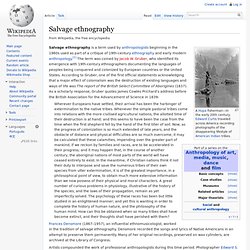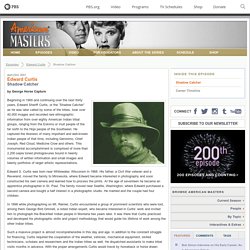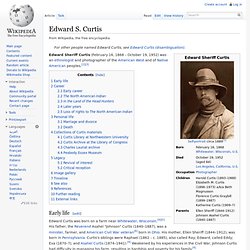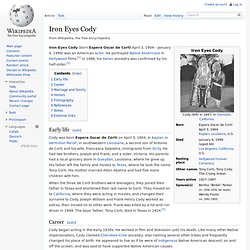

Salvage ethnography. A Hupa fisherman—In the early 20th century, Edward Curtis traveled across America recording photographs of the disappearing lifestyle of American Indian tribes.

Salvage ethnography is a term used by anthropologists beginning in the 1960s used as part of a critique of 19th-century ethnography and early modern anthropology.[1] The term was coined by Jacob W. Gruber, who identified its emergence with 19th-century ethnographers documenting the languages of peoples being conquered and colonized by European countries or the United States. According to Gruber, one of the first official statements acknowledging that a major effect of colonialism was the destruction of existing languages and ways of life was The report of the British Select Committee of Aborigines (1837). As a scholarly response, Gruber quotes James Cowles Prichard's address before the British Association for the Advancement of Science in 1839: Artists compounded the work of professional anthropologists during this time period.
Edward S. Curtis Gallery - North American Indian Photogravures and Photographs. A World Leader in Edward S. Curtis. Edward Curtis - Shadow Catcher. By George Horse Capture Beginning in 1900 and continuing over the next thirty years, Edward Sheriff Curtis, or the “Shadow Catcher” as he was later called by some of the tribes, took over 40,000 images and recorded rare ethnographic information from over eighty American Indian tribal groups, ranging from the Eskimo or Inuit people of the far north to the Hopi people of the Southwest.

He captured the likeness of many important and well-known Indian people of that time, including Geronimo, Chief Joseph, Red Cloud, Medicine Crow and others. This monumental accomplishment is comprised of more than 2,200 sepia toned photogravures bound in twenty volumes of written information and small images and twenty portfolios of larger artistic representations. Edward S. Curtis was born near Whitewater, Wisconsin in 1868. In 1898 while photographing on Mt. Such a massive project is almost incomprehensible in this day and age. To order a copy of Edward S. Edward S. Curtis. Edward Sheriff Curtis (February 16, 1868 – October 19, 1952) was an ethnologist and photographer of the American West and of Native American peoples.[2][3] Early life[edit] Around 1874 the family moved from Wisconsin to Minnesota to join Johnson Curtis's father, Asahel Curtis, who ran a grocery store and was a postmaster in Le Sueur County.[4][6] Curtis left school in the sixth grade and soon built his own camera.

Career[edit] Early career[edit] Dances with Wolves. Costner developed the film over a period of 5 years, with an initial budget of $15 million.

Dances with Wolves had high production values[1] and won seven Academy Awards including Best Picture and the Golden Globe Award for Best Motion Picture – Drama. Much of the dialogue is spoken in Lakota with English subtitles. It was shot in South Dakota and Wyoming, and translated by Albert White Hat, the chair of the Lakota Studies Department at Sinte Gleska University. Plot[edit] In 1863, First Lieutenant John J. Meanwhile Timmons, the wagon driver who transported Dunbar to Fort Sedgwick, is killed and scalped by Pawnee Indians on his way back to Fort Hays. Dances with Wolves (1990. Adam Beach. Adam Beach. Adam Ruebin Beach (born November 11, 1972) is a Canadian Saulteaux actor.

Early life[edit] Born in Ashern, Manitoba, Adam Beach spent his early years with his two brothers on the Lake Manitoba/Dog Creek First Nation Reserve at Lake Manitoba. When Beach was eight years old, his mother, Sally Beach, eight months pregnant with a baby girl, was killed by a drunk driver.[1] Eight weeks after his mother's death, the family stricken with grief, discovered Adam's father, Dennis, drowned nearby the community. It is unclear whether Mr. Beach's death was an accident or if he committed suicide. Beach attended a drama class at Gordon Bell High School. Smoke Signals (1998. Dead Man (1995. Wagons East (1994. Reel Injun. Reel Injun wins Peabody Award Recognizing – in a word – “excellence” April 5, 2011 – REEL INJUN, the documentary by Cree filmmaker Neil Diamond, was honoured with a prestigious Peabody Award, recognizing the best in electronic media.

The awards will be presented May 23 at New York’s Waldorf-Astoria Hotel and puts the film in the company of projects as illustrious and diverse as Glee, The Onion News Network and the legendary series Roots. About the Peabody Awards: The intent of the Peabody Awards is to recognize the most outstanding achievements in electronic media, including radio, television and cable. The Award is determined by one criterion – “Excellence.” For more on the Peabody Awards, please click here. Reel Injun Honoured at Geminis Three awards and two runners-up “Reel Injun is an entertaining and insightful look at the Hollywood Indian, exploring the portrayal of North American Natives through a century of cinema.
For more on the Gemini Awards, please click here. Upcoming U.S. Iron Eyes Cody. Iron Eyes Cody (born Espera Oscar de Corti April 3, 1904 – January 4, 1999) was an American actor.

He portrayed Native Americans in Hollywood films.[1] In 1996, his Italian ancestry was confirmed by his half-sister.[2] Early life[edit] Cody was born Espera Oscar de Corti on April 3, 1904, in Kaplan in Vermilion Parish, in southwestern Louisiana, a second son of Antonio de Corti and his wife, Francesca Salpietra, immigrants from Sicily. He had two brothers, Joseph and Frank, and a sister, Victoria. His parents had a local grocery store in Gueydan, Louisiana, where he grew up. When the three de Corti brothers were teenagers, they joined their father in Texas and shortened their last name to Corti.
Career[edit] Cody began acting in the early 1930s. Skins (2002. Atanarjuat: The Fast Runner. Atanarjuat: The Fast Runner (Inuktitut syllabics: ᐊᑕᓈᕐᔪᐊᑦ (fonts required)) is a 2001 Canadian film directed by Zacharias Kunuk.

Atanarjuat: The Fast Runner (2001.